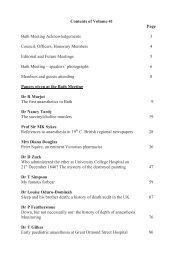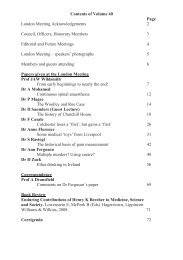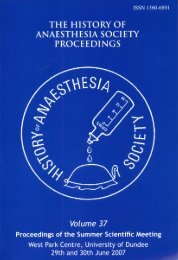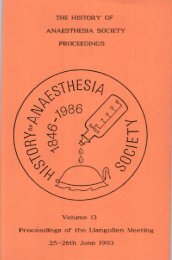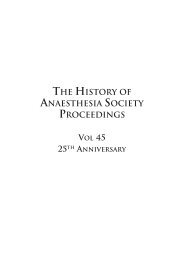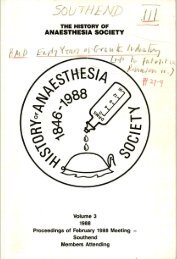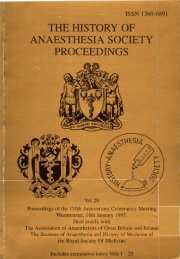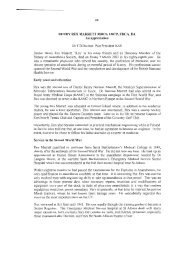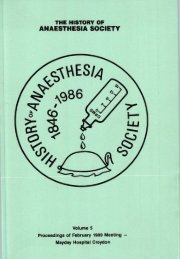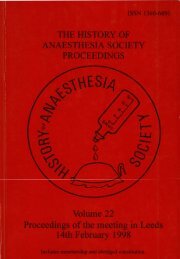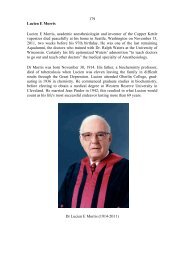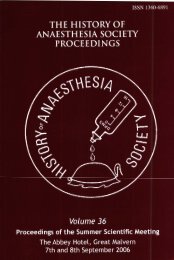3 - History of Anaesthesia Society
3 - History of Anaesthesia Society
3 - History of Anaesthesia Society
You also want an ePaper? Increase the reach of your titles
YUMPU automatically turns print PDFs into web optimized ePapers that Google loves.
In France, the trials conducted by Follin in Paris and Gintrac in Bordeaux<br />
failed. A discussion took place at the Academy <strong>of</strong> Sciences in Paris.<br />
Another discussion followed at the Academy <strong>of</strong> Medicine. Velpeau especially<br />
criticised the reports <strong>of</strong> Vella and Gintrac, copring the results obtained<br />
with the llorrnal evolution <strong>of</strong> the disease. In othsr words, he was looking at<br />
a control group. Claude Bernard w3s especially astonished by the hypothesis<br />
<strong>of</strong> an eventual refractory state to the action <strong>of</strong> cutare. In 1959, 13<br />
comnunications on this s~ibject were published in French journals, four in<br />
Anglo-Saxon literature and four in Germany. nuenty-one patients were<br />
treated in hospitals in Milan and Pavia by Parravicino, Gherini, Monti,<br />
Cuesta, Moroni, dell8Acqua and Gualla between 1859 and 1861. Four <strong>of</strong> these<br />
patients survived. meso data were published in 1864 in the French language<br />
in 'Gazette Medicd d'Orientl(I~t?nbul), Vella's work tms also published in<br />
the same journal and referred to in an article on the same subject in<br />
'L'Union Medicale'(Paris). Retween 1853 and 1873 Wme reported D<br />
mng 22 cases and Busch reprted 6 survivals mng 11 patients. 4, 5':"fi"-PS<br />
From 1880 on, no publications apared abut the use <strong>of</strong> curare in tetanus<br />
patients tmtil 1925 when West, from Scotland, started experiments with a<br />
plrified product. The turning point was in 1952, when Lassen ventiLated for<br />
prolonged periods patients with respiratory muscle paralysis during a<br />
poliomyelitis epidemic. This made the administration <strong>of</strong> a paralysing dose<br />
<strong>of</strong> curare possible in the treatment <strong>of</strong> tetanus. Final*, rlollarst from the<br />
Claude Bernard Hospital, Paris, first reported successful results with d-<br />
tubocurarine.<br />
The early use <strong>of</strong> curare more than a century ago ia tetanus patients, both<br />
subcutaneously and as locally spplied solutions, is interesting. This<br />
method had little effect in improving the prcgnosis <strong>of</strong> the disease but was<br />
successful in some cases in stopping convulsions for a limited period.<br />
References<br />
Bernard C. Etudes physiologiques sur quelcpes poisons americains.<br />
Revue de Deax Wmdes 1864; 53: 164-190.<br />
Bevan DR. ett al. Muscle relx~ants in clinical anesthesia.<br />
Year Book Med. Pub. 1988; 1-2.<br />
Davidson I.W. The Evolution <strong>of</strong> <strong>Anaesthesia</strong>. John Sherratt & Son<br />
1965; 154-158.<br />
Gazette Medical dlOrient. Istanbul. 1860; 10: 178-190.<br />
Lee JA, Atkinson RS. A Synopsis <strong>of</strong> <strong>Anaesthesia</strong>. John Wright 1973.<br />
Vellard. Les curares indiens. Anesth.Analg.Reanim.1973; 20:2.<br />
Vulpian EF. De llemploi du mare come antidote de la strychnine<br />
et come traitmnt du tetanou. LrUnion Itedicale 1357; 11: 25-26.<br />
Cazette Mdic41 de Orient. Istanhl 1864; 2: 17-22.<br />
Gazette iMiz,3le doOrient. Istanbul 1859; 7: 143.<br />
Kern E. TR 'curare en anesthesie. I.Qsson 1950.<br />
LILhion :,ledicale 1959; 49: 817-825.<br />
Sykes !E. Essays on the First Himdred Years <strong>of</strong> <strong>Anaesthesia</strong>.<br />
John Wright 1973.<br />
L'Union Medic3le 1859; 140: 401-404.



